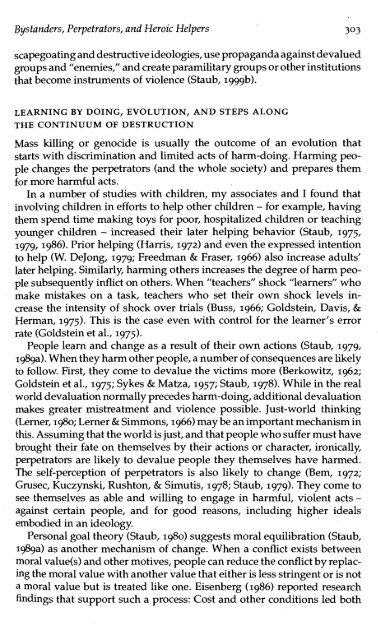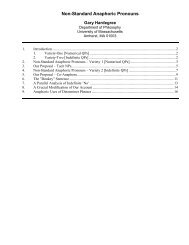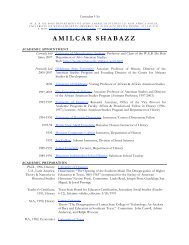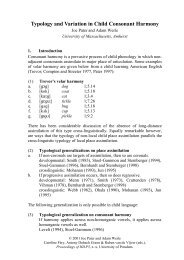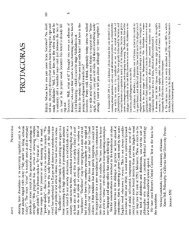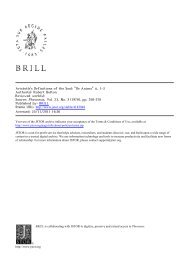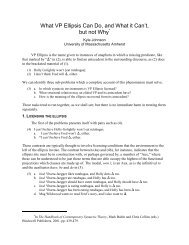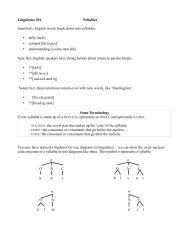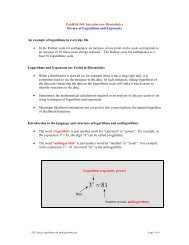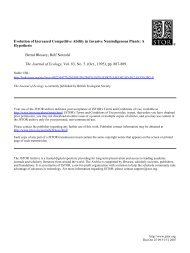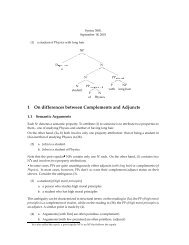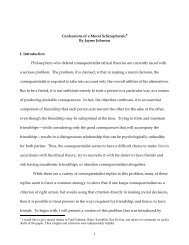The Psychology of Bystanders, Perpetrators, and Heroic Helpers
The Psychology of Bystanders, Perpetrators, and Heroic Helpers
The Psychology of Bystanders, Perpetrators, and Heroic Helpers
Create successful ePaper yourself
Turn your PDF publications into a flip-book with our unique Google optimized e-Paper software.
<strong>Byst<strong>and</strong>ers</strong>, <strong>Perpetrators</strong>, <strong>and</strong> <strong>Heroic</strong> <strong>Helpers</strong> 303<br />
scapegoating <strong>and</strong> destructive ideologies, use propag<strong>and</strong>a against devalued<br />
groups <strong>and</strong> "enemies," <strong>and</strong> create paramilitary groups or other institutions<br />
that become instruments <strong>of</strong> violence (Staub, ~gggb).<br />
LEARNING BY DOING, EVOLUTION, AND STEPS ALONG<br />
THE CONTINUUM OF DESTRUCTION<br />
Mass killing or genocide is usually the outcome <strong>of</strong> an evolution that<br />
starts with discrimination <strong>and</strong> limited acts <strong>of</strong> harm-doing. Harming people<br />
changes the perpetrators (<strong>and</strong> the whole society) <strong>and</strong> prepares them<br />
for more harmful acts.<br />
In a number <strong>of</strong> studies with children, my associates <strong>and</strong> I found that<br />
involving children in efforts to help other children - for example, having<br />
them spend time making toys for poor, hospitalized children or teaching<br />
younger children - increased their later helping behavior (Staub, 1975,<br />
1979,1986). Prior helping (Harris, 1972) <strong>and</strong> even the expressed intention<br />
to help (W. DeJong, 1979; Freedman & Fraser, 1966) also increase adults'<br />
later helping. Similarly harming others increases the degree <strong>of</strong> harm people<br />
subsequently inflict on others. When "teachers" shock "learners" who<br />
make mistakes on a task, teachers who set their own shock levels increase<br />
the intensity <strong>of</strong> shock over trials (Buss, 1966; Goldstein, Davis, &<br />
Herman, 1975). This is the case even with control for the learner's error<br />
rate (Goldstein et al., 1975).<br />
People learn <strong>and</strong> change as a result <strong>of</strong> their own actions (Staub, 1979,<br />
1989a). When they harm other people, a number <strong>of</strong> consequences are likely<br />
to follow. First, they come to devalue the victims more (Berkowitz, 1962;<br />
Goldstein et al., 1975; Sykes & Matza, 1957; Staub, 1978). While in the real<br />
world devaluation normally precedes harm-doing, additional devaluation<br />
makes greater mistreatment <strong>and</strong> violence possible. Just-world thinking<br />
(Lerner, 1980; Lerner & Simmons, 1966) may be an important mechanism in<br />
this. Assuming that the world is just, <strong>and</strong> that people who suffer must have<br />
brought their fate on themselves by their actions or character, ironically<br />
perpetrators are likely to devalue people they themselves have harmed.<br />
<strong>The</strong> self-perception <strong>of</strong> perpetrators is also likely to change (Bem, 1972;<br />
Grusec, Kuczynski, Rushton, & Simutis, 1978; Staub, 1979). <strong>The</strong>y come to<br />
see themselves as able <strong>and</strong> willing to engage in harmful, violent acts -<br />
against certain people, <strong>and</strong> for good reasons, including higher ideals<br />
embodied in an ideology.<br />
Personal goal theory (Staub, 1980) suggests moral equilibration (Staub,<br />
1989a) as another mechanism <strong>of</strong> change. When a conflict exists between<br />
moral value(s) <strong>and</strong> other motives, people can reduce the conflict by replacing<br />
the moral value with another value that either is less stringent or is not<br />
a moral value but is treated like one. Eisenberg (1986) reported research<br />
findings that support such a process: Cost <strong>and</strong> other conditions led both


